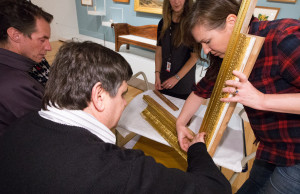Because this year is my Year of Serious Writing I have been reflecting on writing about disability. You could say I have been writing about disability for many years, and I have, but writing from a deeply personal perspective and exploring events, memory and distance in place and time is very different from journalism, reports, blogs on information access and related themes, even speaking notes.
As if writing about memory and the past are not difficult enough, writing about a life with disability is more so. Drawing the meanings and lessons complicates my task even more.
I must explore and create my truth through a language that shifts and flows, an unstable country, a language that seems in some ways not up to the task and in others so nuanced and complicated that I may drown.
For example, when I think about the everyday language we use in the disability world I encounter problems. The words “disability” and “impairment” themselves are deeply contested, never mind such phrases as “the lived experience of disability.” The language used is also littered with medical and sociological jargon. I had to explain what DNR meant recently on Facebook. ( It means do not resuscitate, instructions sometimes found on a medical file.) My fault for using jargon.
The “social model” of disability which is a strong thread in disability identity is not well understood, either within or beyond the disability world. Sociology and psychology, even religion describe disability as object rather than subject. Medicine defines body as machine. None of them take real account of meaning for the heart, soul and spirit.
Internalised stigma and ableism, by me and the reader also complicates the writing process. We have all internalised social oppression that declares disability to be undignified, the “fate worse than death” scenario most disabled people steadfastly deny in the face of prevalent community incomprehension. We often feel like second class citizens in our own country. That has interesting implications for a writer.
The disability human rights and equality on which I have focused so much of my life’s work and commitment are also contested subjects. They are couched in frustratingly legal terminology. Terms such as “reasonable accommodation,” (the degree to which an employer, education provider, retailer, transport and other services and so on must meet the disability requirements of their customers,) have a degree of currency. But that term in particular is legalistic, grudging and ungenerous, lacking a warm and wholehearted welcome, calling into question another contested word, “inclusion”.
I also have to negotiate the “poor me,” “aint it awful” pity scenario and its equally unacceptable opposite, “disability porn,” two extremes so popular in the media and a trap for the unwary writer.
For me it has become increasingly necessary to travel beyond the clinical, the medical, the legal, the sociological. I have to banish stigma and negative belief to excavate the more dangerous depths of meaning.
It’s a scary enterprise for a private person. I may uncover sadness, rage, rejection, even shame in those depths. But memory can discover surprise and delight as well as pain. There is also joy, humour, friends found and strength drawn from a strong sense of community.










